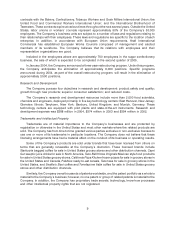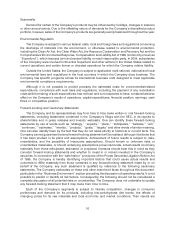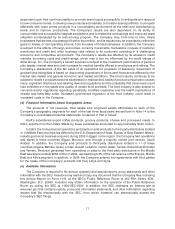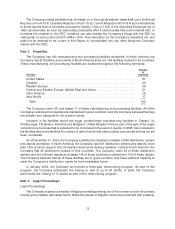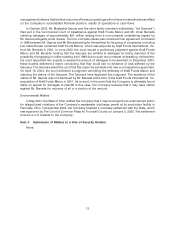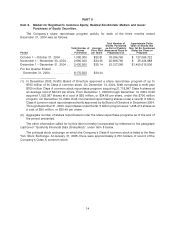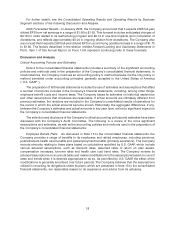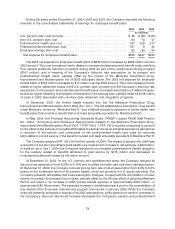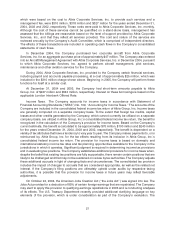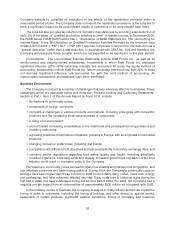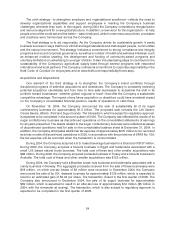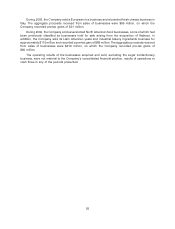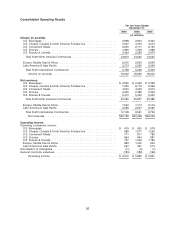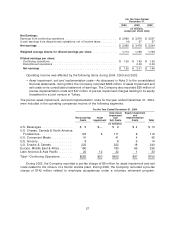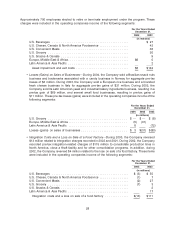Kraft 2004 Annual Report Download - page 20
Download and view the complete annual report
Please find page 20 of the 2004 Kraft annual report below. You can navigate through the pages in the report by either clicking on the pages listed below, or by using the keyword search tool below to find specific information within the annual report.
During the years ended December 31, 2004, 2003 and 2002, the Company recorded the following
amounts in the consolidated statements of earnings for employee benefit plans:
2004 2003 2002
(in millions)
U.S. pension plan cost (income) ................................. $ 46 $(46) $(33)
Non-U.S. pension plan cost ..................................... 93 74 47
Postretirement health care cost .................................. 237 229 217
Postemployment benefit plan cost ................................ 167 6 35
Employee savings plan cost .................................... 92 84 64
Net expense for employee benefit plans .......................... $635 $347 $330
The 2004 net expense for employee benefit plans of $635 million increased by $288 million over the
2003 amount. This cost increase primarily relates to increased postemployment benefit costs, resulting
from several workforce reduction programs during 2004 as part of the overall restructuring program
($167 million), and a lowering of the Company’s discount rate assumption on its pension and
postretirement benefit plans, partially offset by the impact of the Medicare Prescription Drug,
Improvement and Modernization Act of 2003 discussed below. The 2003 net expense for employee
benefit plans of $347 million increased by $17 million over the 2002 amount. This cost increase primarily
relates to higher settlement losses in the U.S. pension plan, a lowering of the Company’s discount rate
assumption on its pension and postretirement benefit plans, increased amortization of deferred losses,
as well as higher matching of employee contributions in the savings plan, partially offset by $148 million
of costs in 2002 associated with voluntary early retirement and integration programs.
In December 2003, the United States enacted into law the Medicare Prescription Drug,
Improvement and Modernization Act of 2003 (the ‘‘Act’’). The Act establishes a prescription drug benefit
under Medicare, known as ‘‘Medicare Part D,’’ and a federal subsidy to sponsors of retiree health care
benefit plans that provide a benefit that is at least actuarially equivalent to Medicare Part D.
In May 2004, the Financial Accounting Standards Board (‘‘FASB’’) issued FASB Staff Position
No. 106-2, ‘‘Accounting and Disclosure Requirements Related to the Medicare Prescription Drug,
Improvement and Modernization Act of 2003’’ (‘‘FSP 106-2’’). FSP 106-2 requires companies to account
for the effect of the subsidy on benefits attributable to past service as an actuarial experience gain and as
a reduction of the service cost component of net postretirement health care costs for amounts
attributable to current service, if the benefit provided is at least actuarially equivalent to Medicare Part D.
The Company adopted FSP 106-2 in the third quarter of 2004. The impact of adoption for 2004 was
a reduction of pre-tax net postretirement health care costs and an increase in net earnings of $24 million.
In addition, as of July 1, 2004, the Company reduced its accumulated postretirement benefit obligation
for the subsidy related to benefits attributed to past service by $315 million and decreased its
unrecognized actuarial losses by the same amount.
At December 31, 2004, for the U.S. pension and postretirement plans, the Company reduced its
discount rate assumption from 6.25% to 5.75% and modified its health care cost trend rate assumption.
At December 31, 2004, the Company reduced its long-term rate of return assumption from 9.0% to 8.0%
based on the investment return of its pension assets, which are primarily in U.S. equity securities. The
Company presently anticipates that these assumption changes, coupled with the amortization of lower
returns on pension fund assets in prior years, partially offset by the full year effect of adopting Medicare
Part D, will result in an increase in 2005 pre-tax benefit expense of approximately $200 million, or
approximately $0.08 per share. The expected increase in benefit expense is prior to the consideration of
any impact of the three-year restructuring program announced in January 2004. While the Company
does not presently anticipate a change in its 2005 assumptions, a fifty-basis point decline (increase) in
the Company’s discount rate would increase (decrease) the Company’s pension and postretirement
19


